- Camouflage Coating Using Photochromic Microcapsules and Epoxy Resin
Young Been Kim# , Woong Chan Han# , Jeonghyeon Heo# , Kie Yong Cho*, Sujong Chae*, Seyoung Kee, and Dae Seok Kim†

Department of Polymer Engineering, Pukyong National University, 45 Yongso-ro, Nam-gu, Busan 48513, Korea
*Department of Industrial Chemistry, Pukyong National University, 45 Yongso-ro, Nam-gu, Busan 48513, Korea- 광색성 마이크로 캡슐과 에폭시 수지를 이용한 위장 코팅법
부경대학교 고분자공학과, *부경대학교 공업화학과
Reproduction, stored in a retrieval system, or transmitted in any form of any part of this publication is permitted only by written permission from the Polymer Society of Korea.
Using photochromism of a diarylethene, we demontrate an easy but highly effective coating method for a camouflage application. The photochromic ink is consisting of capsule type of photochromic pigments and UV curable epoxy resin, reversibly presenting colored pattern in response to ultraviolet (UV) light. The transmittance of the coatings was investigated based on concentrations of the photochromic microcapsules, we have found that 5 wt% of the microcapsules in epoxy resin is most appropriate for camouflage with background. Besides, in order to increase mechanical stability of the coating, thin protective layer including acrylate chemicals is further coated on the patterns. By taking advantage of bar-coating with various mask pattern, different patterns were successfully coated on various types of surfaces such as wood, glass, general concrete wall and even curved surfaces. Based on the coating method, camouflage application for an encryption quick response (QR) pattern was successfully demonstrated.
Diarylethene의 광 변색성을 이용하여, 가역적 위장표시 응용을 위한 간단하지만 매우 효과적인 코팅 방법을 제안한다. 여기서 사용한 광 변색성 잉크는 diarylethene을 포함하는 캡슐형 광 변색성 안료와 UV 경화형 에폭시 수지로 구성되어 있으며, 코팅 된 패턴은 자외선(UV) 빛에 반응하여 가역적으로 변색되는 특성을 안정적이고 신뢰성 높게 보여주었다. 배경과의 위장특성을 위해, 코팅된 패턴의 투과율이 광 변색성 마이크로 캡슐의 농도에 따라 조사되었으며, 그 결과, 에폭시 수지의 마이크로 캡슐의 약 5 wt%가 위장특성에 가장 적합하다는 것을 확인하였다. 나아가, 패턴된 코팅의 기계적 안정성을 높이기 위해 acrylates 물질을 포함하는 얇은 보호층이 패턴에 추가로 코팅되어 우수한 마모저항성을 나타냄을 확인하였다. 다양한 마스크 패턴과 바 코팅을 활용하여 목재, 유리, 일반 콘크리트 벽체, 곡면 등 다양한 표면에 다양한 패턴을 성공적으로 코팅하였다. 이런 코팅법을 기반으로 암호화 quick response(QR) 패턴을 위한 위장 코팅 응용이 성공적으로 시연되었다.
As the ratio of fluorosilicone rubber (FVMQ) increased, the elongation at break increased, and the oil resistance was affected by the correlation between the type of the test oil and blend ratio of FVMQ/silicone rubber (VMQ).

Keywords: camouflage coating, photochromic pigment, epoxy resin, encrypt patterning.
This research was supported by Pukyong National University Development Project Research Fund, 2021. This work was supported by the National Research Foundation of Korea (NRF) grant funded by the Korea government (MSIT) (2021K1A3A1A21039767 & 2021R1F1A1047516).
The authors declare that there is no conflict of interest.
Information is available regarding the Intensity profiles of PL spectra at 583 nm with different area over the coatings. The materials are available via the Internet at http://journal.polymer-korea.or.kr.)
PK_2022_046_02_288_Supporting_Information_template.pdf (246 kb)
Supplementary Information
Living organisms such as cephalopods, chameleons, and satanic leaf-tailed geckos are cryptically colored with a wide range of hues and patterns, closely matching their respective environments for camouflage, signaling, or energy regulation.1,2 Notably, these organisms can often dramatically change the intensity or color of these patterns. Furthermore, their capability of camouflage has received considerable attention in various research fields, industries, and special institutes such as the military.3 One of the most promising materials for camouflage is chromic dye, whose molecular structure changes under external stimuli such as light,4 heat,5 chemicals,6 mechanical force,7 or their combination.8 The combination of these stimuli can reversibly produce two isomers with different colors.
Camouflage requires that the color or pattern should change according to the background color or geometries,9 while the camouflage objects should also be able to reveal themselves depending on the specific condition. Besides, the alternation between camouflaged and un-camouflaged states should be fast in response with the condition. Thus, a transformation of information can be selectively and actively controlled by the camouflage technique for various applications such as in encryption displays, anti-counterfeiting, responsive photonic devices.10 Hence, among the chromic materials, using photochromic materials are one of mostly preferred strategy for the camouflage applications owing to the remote and fast variations in color and pattern with external stimuli.11 Several scientific and technological advances have been made in the processing and usage of photochromic dyes for final applications which have significant commercial value.12,13 However, camouflage coating applications face certain challenges at the practical level. One of them is the transparency of the coating, which is a critical factor in order to effectively disguise with the background. Another important issue is the development of proper coating supporters for chromic dyes, because organic chromic dyes alone are difficult to utilize in coating applications.14 Furthermore, other issues associated with camouflage coating applications are cost, stability, reliability, and easy accessibility. To address these issues, various methods to incorporate chromic dyes have been suggested; however, each method requires an optimization process for final applications depending on the type of dye or carrier and application field, which will be a significant hurdle for practical applications.15
The micro-capsulation of photochromic dyes is a promising approach to attain supporters that are capable of stably containing chromic molecules. Owing to their easy processability, accessibility, and abundant functionality,16-18 photochromic microcapsules have been widely used in silk printing,19 wood,20 textiles,21,22 and sensory coatings.23,24 In this study, we demonstrate an easy and effective camouflage coating method using a photochromic ink. This ink consisted of micro-capsulated photochromic pigments (MCPPs) and ultraviolet (UV)-curable epoxy resin, which can reversibly change color in response to UV light. For the camouflage, the transmittance of the coatings is investigated based on concentrations of the photochromic microcapsules, it is found that 5 wt% of the microcapsules in epoxy resin is most appropriate for camouflage with background. In addition, to increase the mechanical stability of the coating, a thin layer of acrylate chemicals is further coated on the patterns. By taking advantage of bar-coating with various mask pattern, different patterns are successfully coated on various types of surfaces such as wood, glass, general concrete wall and even curved surfaces. Based on the coating method, camouflage applications for an encryption quick response (QR) pattern is successfully shown.
Materials. The photochromic pigment, i.e. MCPP, and UV curable epoxy resin were purchased from Ons, Inc. and Baekyong P&C, S. Korea, respectively. 50 μm thick-PET film (Formtec, Inc., S. Korea) was used for the coating mask patterns. For the protective coating, trimethylolpropane triacrylate (Surkorea, S. Korea) was purchased. Since the MCPPs include a solvent, 1,2-dimethyl-4-(1-phenylethyl)benzene, in order to confirm a possible degradation of photochromic property by the solvent-evaporation, we have checked the color change of the MCPPs over last 6 months, there was no significant changes in photochromic responsibility. This is possibly due to relatively high boiling point of the solvent, which is ~148 ℃, therefore it seems to be stable in ambient condition at room temperature. Furthermore, because ~20 wt% of the photochromic dyes is dissolved in the solvent in the capsules, thermodynamically the boiling point elevation of the solvent may occur by the solute, photochromic dyes.
Preparation of Coating Solution. The MCPPs and epoxy resin were mechanically blended in beaker by using vortex mixer (VM-10, Witeg, S. Korea) for 3 minutes and sonicated for 10 minutes in order to remove bubbles in the solution. in the bar-coating process, first the mask-pattern film of PET is printed and cut as required in the camouflage patterns such as text or graphics. And then the mask pattern film is placed onto a substrate and coated by the bar coater (TMAX-VFC-150C, TMAX Battery equipment, China). Then, removing the PET film from the substrate and curing the coating using UV light of 354 nm, 10 mW/cm2 (Ushio Shenzhen, Inc., Japan). To improve chemical and mechanical stability, trimethylolpropane tri-acrylate were further coated on the patterns and cured with UV light for 10 minutes.
For the control molecules of diarylethene, MCPPs were dissolved in chloroform with vigorously stirring for 1 hour. Then, the solution was filtered using suction flask with vacuum pump and the extruded solution was evaporated using rotary vacuum evaporator. The extruded molecules were dispersed in epoxy resin.
Materials Material Characterization. Optical texture of the UV-curable photochromic ink was observed using optical microscope (LV100POL, Nikon, Japan). The transmittance and the photoluminescent (PL) spectra of the photochromic camouflage coating on glass were collected using a spectrometer (USB-2000+, Ocean Optics, USA) with a halogen lamp. A sand abrasion test was carried out following a method reported in the literature.25,26 Typically, 20-80 g of commercial sand (Sigma-Aldrich, USA) was dropped onto the coated surface from a height of 40 cm while the substrate was inclined at 45o. All photographs were taken using iPhone 13 (Apple. Inc., U.S.A.)
Results and Discussion Subheading. For a versatile photochromic coating process, two key approaches were used. One is a solution process using UV-curable epoxy as a coating medium. Specifically, UV-curable epoxy is broadly used as an industrial material for sealing, bonding, and coating because it entails a simple, fast, and an inexpensive process. Another method uses polymeric microcapsules, including photochromic dyes, called MCPPs, to obtain a well-dispersed state of the photochromic component throughout the epoxy medium. The photochromic molecules are generally insoluble in the epoxy resin, inducing aggregation of the dye molecules. This may degrade the photochromic performance over the coated surface. In contrast, the dispersion of MCPPs can be simply obtained through mechanical stirring, and the dispersed state can be quickly locked by the UV curing process; thus, a MCPP dispersed in epoxy resin was used in this study. The MCPPs can be prepared through emulsification and in-situ polymerization, where the photochromic dye is dissolved in the inner liquid phase, 4-(1-phenylethyl)-o-xylene, styrene maleic anhydride polymer shell as the outer phase, and an intermediate layer, polyoxymethylene melamine, playing the role of a surfactant polymer (Figure 1(a)). The photochromic dyes used in this study are P-type (thermally irreversible, but photochemically reversible) photochromic molecules including diarylethene. These dyes can be converted from a ring-open to ring-closed form by absorbing UV light of wavelength 354 nm, resulting in the appearance of a purple color from a colorless state.
Then, for the bar-coating method based on the solution process, we prepared a UV-curable photochromic ink consisting of MCPPs and UV-curable epoxy resin (Figure 1(b)). The UV-curable photochromic ink was simply prepared by mechanically mixing the MCPPs and epoxy resin for ~10 min. As a result, the MCPPs are dispersed well through the epoxy medium while they exhibit a partial aggregation (Figure 1(c)). As shown in optical microscopic image, the MCPPs show spherical shapes with size distribution from ~0.4 to ~9 μm (Figure 1(c) and 1(d)). The photochromic ink casted onto slide glass clearly presents the colorless state and homogeneous colored emergence throughout the pattern by UV-irradiation. However, comparing to the well-dispersed state of MCPPs in epoxy resin, when the photochromic dye molecules extracted from MCPPs were also dispersed in epoxy resin in the same manner, as shown in optical microscope(OM) image (Figure 1(e)), the dispersion of dye molecules was extremely inhomogeneous. This result is possibly due to its immiscibility with epoxy resin resulting in a phase separation of the dye molecules with the molecular aggregation. Accordingly, the epoxy coating with the dye molecules shows inhomogeneous colored state by UV-irradiation (inset of Figure 1(e)). Moreover, the homogeneousness of dispersion of the MCPPs and the dye molecules was quantitatively shown in intensity profiles of PL spectra were measured at 583 nm with different parts over the coatings, respectively (Figure S1). As a result of this, it is reasonably concluded that the capsulation of photochromic dye is highly proper strategy for the capability and reliability of displaying colored patterns with high quality.
The photoluminescent (PL) intensity of the dried MCPPs powder under UV on/off conditions (Figure 2(a)) revealed that the MCPPs included three different diarylethene molecules. These molecules exhibited PL wavelengths of 580, 515, and 412 nm, respectively, which appeared purple in color to the naked eye (inset of Figure 2(a)). The PL spectra of the dried MCPPs powder and the MCPPs dispersed in epoxy resin showed no significant changes (Figure 2(b)). And the UV-response rate of the MCPPs dispersed in epoxy was measured with UV light (354 nm, 10 mW/cm2), and the results showed that the absorbance intensity of the MCPPs reached a maximum in a few seconds; further, the MCPPs returned to the colorless states within 40 s. This suggests that the reversible color change of the MCPPs can be achieved within a minute (Figure 2(c)).
Then, to make a certain coating pattern using bar-coating method, patterned masks were simply prepared by cutting a polyethylene terephthalate film, as illustrated in Figure 3(a). The mask pattern was placed onto the target substrate, that is glass substrate, and the photochromic ink was coated via the bar-coating and cured by UV irradiation. The coated pattern was obtained on the glass substrate by detaching the photomask film. To make the coated pattern chemically and mechanically resistant, a protective layer consisting of trimethylolpropane triacrylate was further coated over the patterned surface. Through this process, coating of a pattern “PKNU” was demonstrated using photochromic ink with 10 wt% MCPPs (inset of Figure 3(a)). Moreover, to investigate the sustainability and stability of the color change of the coating under repeated UV irradiations, we conducted 100th cycles to evaluate the stability of the reversible color changes (Figure 3(b), (c)). No remarkable degradation in the photochromic performance was observed for over 100 cycles, indicating long-life stability of the coating.
To utilize the coating patterns for reversible camouflage with various environmental backgrounds, transparency of the pattern is an important factor. That is, higher transparency allows an excellent camouflage with the background when the photochromism is deactivated. Since the scale of MCPPs is a few micrometer (Figure 1(d)), Mie scattering by the MCPPs increases as the concentration increases, inducing the pattern becomes blur and white.27 For this, in order to find the most proper concentration of MCPPs, the transparency of the photochromic ink was investigated by varying the fractional weight of the MCPPs with respect to that of epoxy resin from 1 to 30 wt%. Here, visible light of wavelength 420-800 nm was used by using a UV cutter film to avoid photochromic activation while measuring the transmittance. As shown in Figure 4(a), the transparency of the coated patterns decreases as the fractional weight of MCPPs increases because of light scattering at the interface between MCPPs and epoxy medium. The intensity of absorbance increases and the color change becomes more vivid as the fractional weight of MCPPs increases. However, the photochromic inks with a fractional weight above 10 wt% begin to show opacity when they are in the UV-off state, and this opaque state is clearly seen in the pattern with 30 wt% MCPPs (Figure 4(b)). This indicates that such photochromic inks might be only suitable for camouflage performance with a white background, but not for a colored background. Thus, the photochromic ink with 5 wt% MCPPs was selected for a camouflage coating that is applicable under various backgrounds.
Epoxy resin is a well-known material for soft lithography because of its high wettability on various surfaces with micrometer and even nanometer scale.28 By taking advantage of the wettability of epoxy resin, camouflage coating was conducted on the glass surface and other materials such as wood, marble, and concrete wall (Figure 4(c)-(e), respectively) by the solution coating process using the UV-curable photochromic ink with 5 wt% MCPPs. It was particularly shown that the coating was successfully conducted on wood and concrete walls that have relatively rougher surfaces than those of glass. In addition, the camouflage pattern was also successfully coated on the curved surfaces of a glass cup (Figure 4(f)). Before UV irradiation of the coated patterns, the patterns presented plausible camouflage performance with their background. After UV irradiation, the patterns became colored, exhibiting vivid contrast with their background (see bottom row of Figure 4(c)-(f)).
As a result, these versatile coatings can be applied in various camouflage applications, such as encryption, anti-counterfeiting, responsive photonic devices, and aesthetic design. As a proof of this concept, we demonstrated camouflage coating pattern as encryption display films that are capable of presenting a certain colored pattern over a specific area of QR code on the millimeter scale (Figure 5(a)). The QR code only works when UV light irradiates the patterns, while it prevents access to the corresponding webpage otherwise (Figure 5(b)).
Finally, we investigated the mechanical resistance of the camouflage coating via a sand abrasion test using a method similar to that reported in the literature.24,25 Sand grains of diameter 100-500 μm were dropped from a height of ~40 cm, corresponding to an impinging energy of ~9×10−7 J per grain (Figure 5(c)). After dropping 100 g of sand, the coating was retained and showed no remarkable variation in the photochromic performance.
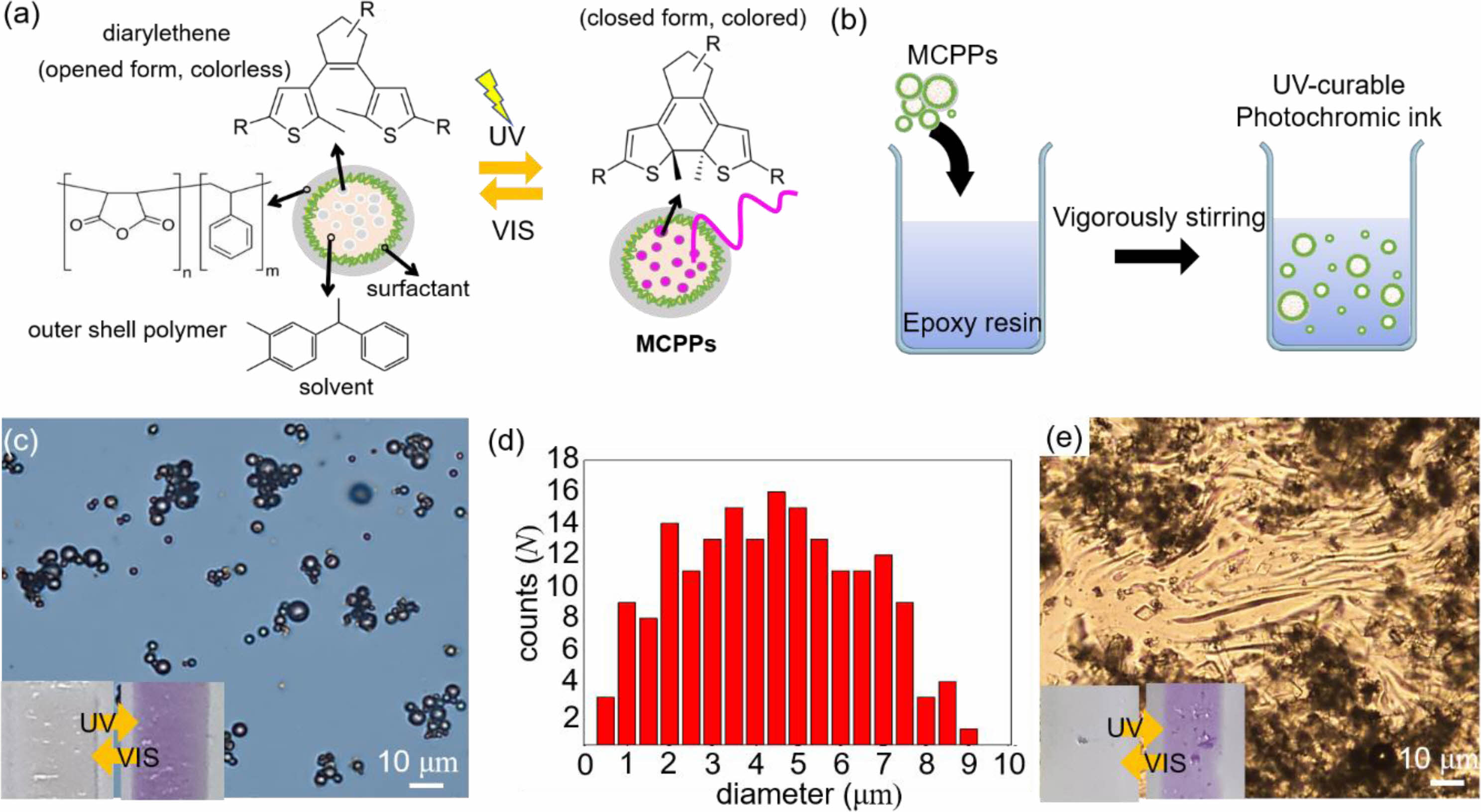
|
Figure 1 (a) A schematic illustration and chemical structures of MCPPs; (b) schematic illustration showing the preparation of UV curable photochromic ink including MCPPs and epoxy resin; (c) optical microscope (OM) image showing MCPPs dispersed in epoxy resin; (d) the number of MCPPs as a function of the diameters; (e) OM image showing the diarylethene dyes dispersed in epoxy resin. The insets in (c) and (e) presenting photographs showing photochromism of the MCPPs and diarylethene dyes, dispersed in epoxy resin, respectively. |

|
Figure 2 (a) The UV-Vis spectroscopy photoluminescent (PL) spectra of MCPPs in UV-activated and UV-off states; (b) PL spectra of powdered MCPPs and their dispersion in epoxy resin; (c) PL intensity variation of MCPPs under UV-on and -off state as a function of time. |
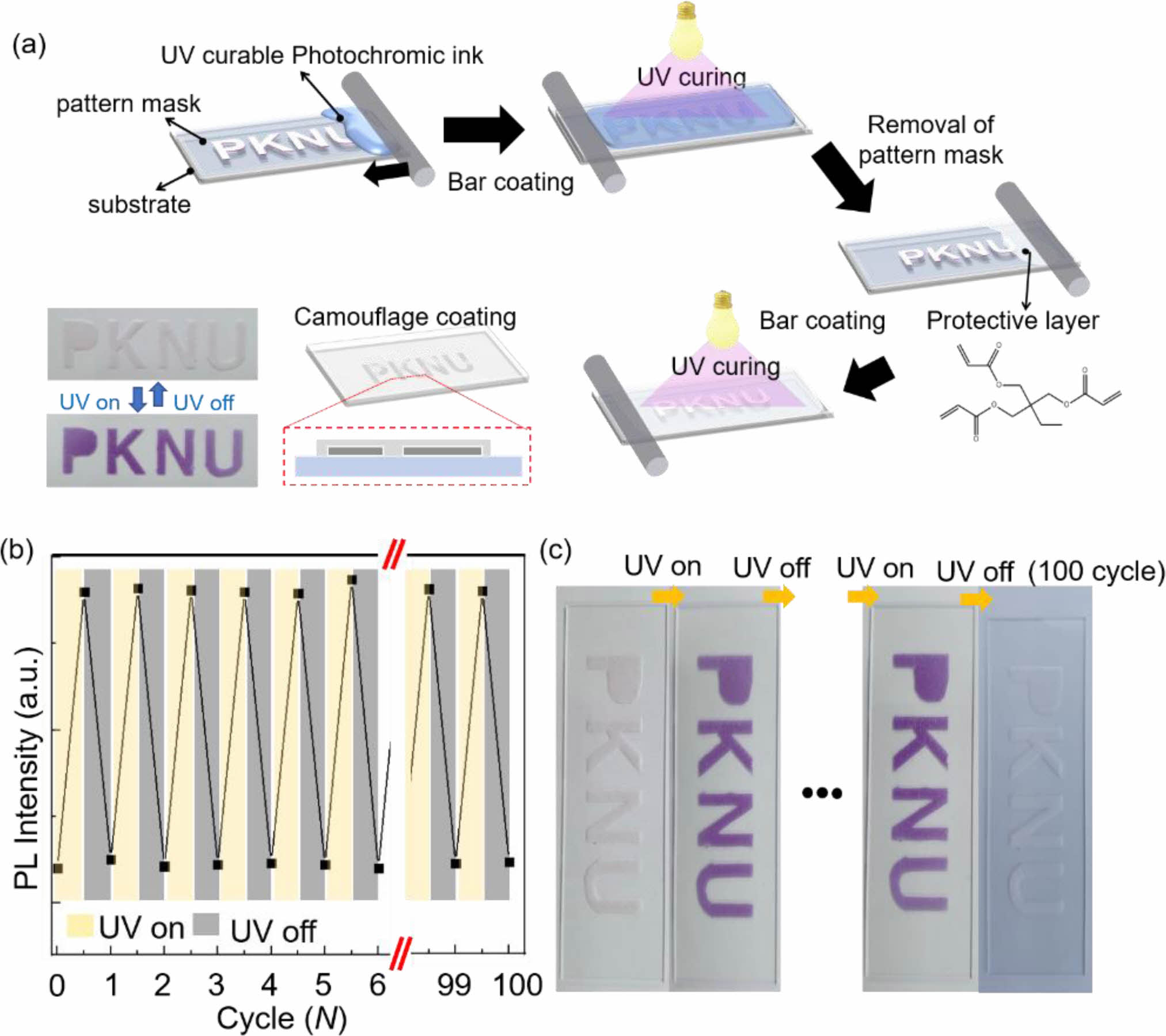
|
Figure 3 (a) Schematic diagram of camouflage coating process using UV curable photochromic ink (The inset shows photographs of the camouflage coating, “PKNU” before and after UV irradiation); (b) PL intensity variation with cycles of UV-on and -off (each PL intensity was measured when it reaches to maximum and minimum intensities in UV-on and -off states, respectively); (c) the corresponding photographs for first cycle and 100th cycle. |
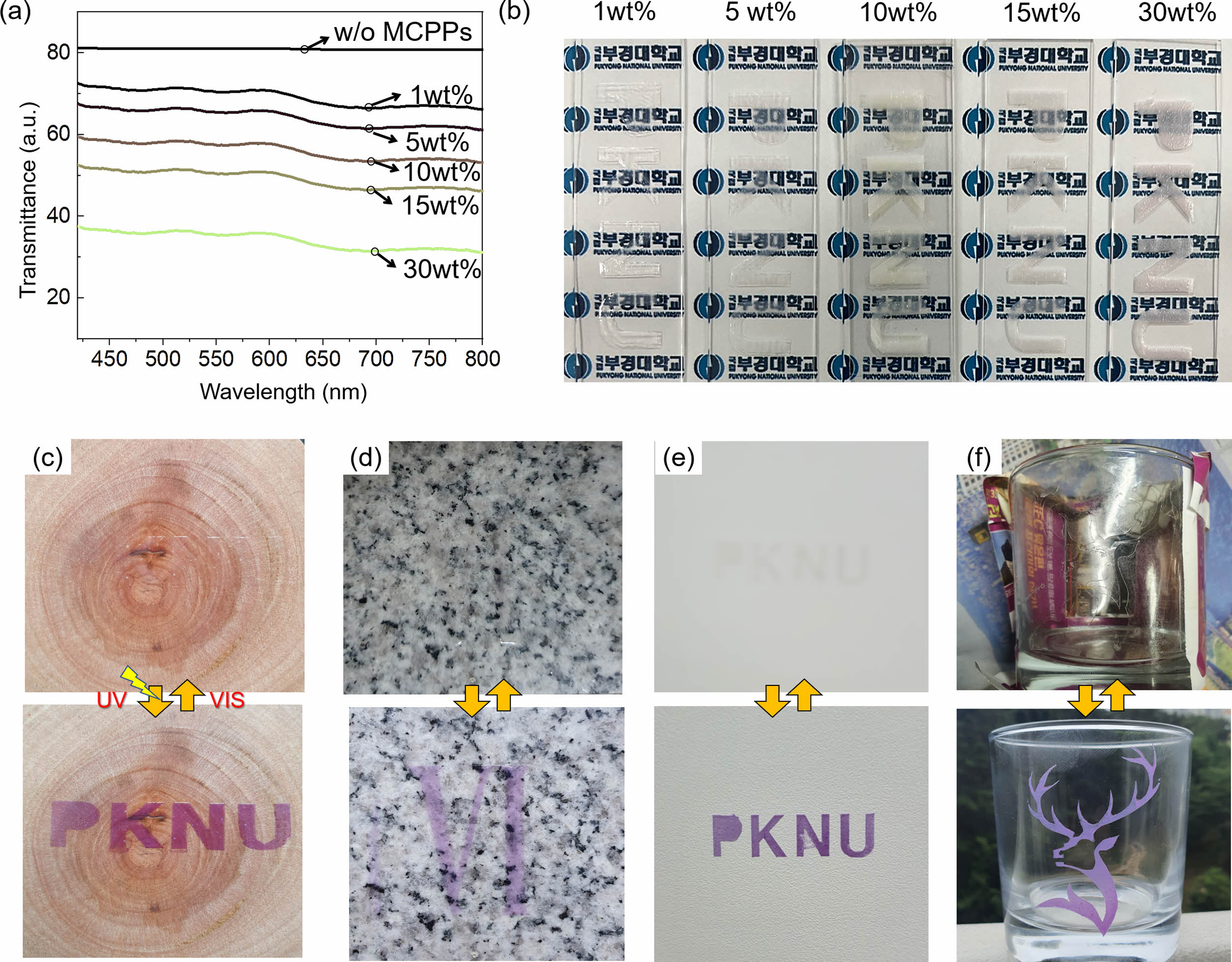
|
Figure 4 (a) Transparency curves; (b) photographs of coated patterns of photochromic ink with different fractional weight of MCPPs (1 wt%, 5 wt%, 10 wt%, 15 wt%, 30 wt%), respectively. Difference in transparency of photochromic ink by fractional weight of MCPPs (1 wt%, 5 wt%, 10 wt%, 15 wt%, 30 wt%) with respect to epoxy resin. (c-f) Application of the camouflage coating on various surface of materials: (c) wood; (d) marble; (e) concrete wall; (f) glass cup. |
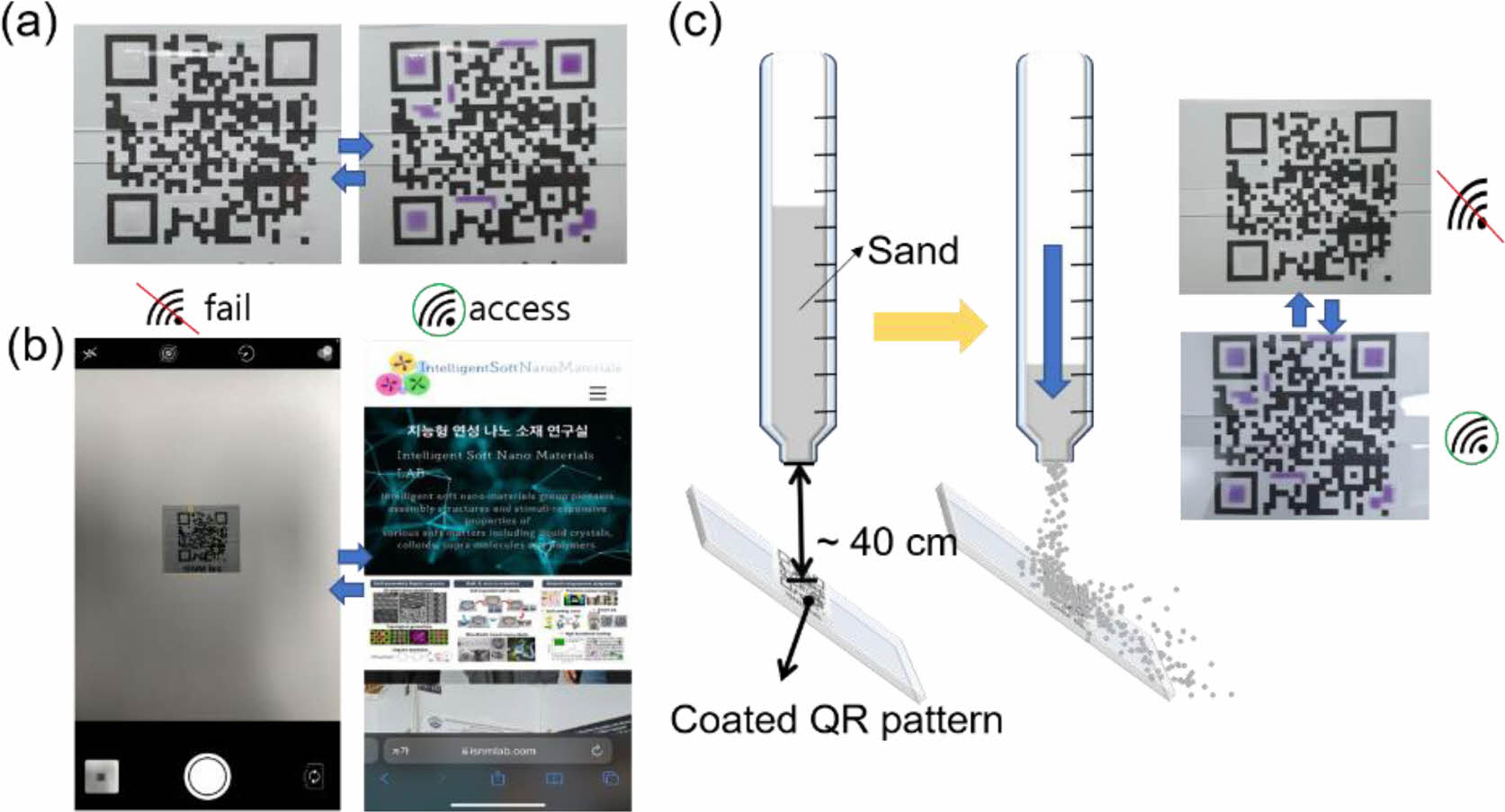
|
Figure 5 Applications of camouflage coating pattern and sand abrasion test: (a) Encrypted display QR code that is working only when a pattern appears by UV li ght; (b) screen shots of mobi le phone showing access-fail and -successful as the pattern is stimulated by UV, respectively; (c) illustration of experimental set-up of the sand abrasion test and photographs of the camouflage pattern under UV irradiation before and after sand abrasion test. |
We demonstrated an easy and highly effective camouflage coating method for a photochromic ink consisting of MCPPs and UV-curable epoxy resin. The coating reversibly changed color based on UV light. Using mask patterns, different patterns were successfully coated on different surfaces such as wood, glass, general concrete walls, and even curved surfaces. Based on the camouflage coating, encryption display films for QR codes were successfully demonstrated. The result implies that the stimuli-responsive QR code can be used as a base technique that is able to spatially control and limit the information access as the QR code is only activated under UV-irradiation. Thus, we believe that the camouflage coating approach can be used in security-based coating applications such as in encryption displays, anti-counterfeiting, responsive photonic devices, and smart design of various products.
- 1. Ruxton, G. D. Non-Visual Crypsis: A Review of the Empirical Evidence for Camouflage to Senses Other than Vision. Phil. Trans. R. Soc. B 2009, 364, 549-557.
-

- 2. Cuthill, I. C. Camouflage. J. Zool 2019, 308, 75-92.
-

- 3. Qiao, Y.; Meng, Z.; Wang, P.; Yan, D. Research Progress of Bionic Adaptive Camouflage Materials. Front. Mater. 2021, 8, 637664.
-

- 4. Pardo, R.; Zayat, M.; Levy, D. Photochromic Organic-Inorganic Hybrid Materials. Chem. Soc. Rev. 2011, 40, 672-687.
-

- 5. Zhu, C. F.; Wu, A. B. Studies on the Synthesis and Thermochromic Properties of Crystal Violet Lactone and Its Reversible Thermo- chromic Complexes. Thermochimica Acta 2005, 425, 7-12.
-

- 6. Liu, P. Electrochromic and Chemochromic Performance of Mesoporous Thin-Film Vanadium Oxide. Solid State Ionics 2003, 165, 223-228.
-

- 7. Mitani, M.; Ogata, S.; Yamane, S.; Yoshio, M.; Hasegawa, M.; Kato, T. Mechanoresponsive Liquid Crystals Exhibiting Reversible Luminescent Color Changes at Ambient Temperature. J. Mater. Chem. C 2016, 4, 2752-2760.
-

- 8. Karshalev, E.; Kumar, R.; Jeerapan, I.; Castillo, R.; Campos, I.; Wang, J. Multistimuli-Responsive Camouflage Swimmers. Chem. Mater. 2018, 30, 1593-1601.
-

- 9. Michalis, C.; Scott-Samuel, N. E.; Gibson, D. P.; Cuthill, I. C. Optimal Background Matching Camouflage. Proc. R. Soc. B. 2017, 284, 20170709.
-

- 10. Kim, S.-U.; Lee, Y.-J.; Liu, J.; Kim, D. S.; Wang, H.; Yang, S. Broadband and Pixelated Camouflage in Inflating Chiral Nematic Liquid Crystalline Elastomers. Nat. Mater. 2022, 21, 41-46.
-

- 11. Barachevsky, V. A. Advances in Photonics of Organic Photochro- mism. J. Photochem. Photobiol. A 2018, 354, 61-69.
-

- 12. Nigel Corns, S.; Partington, S. M.; Towns, A. D. Industrial Organic Photochromic Dyes. Color. Technol. 2009, 125, 249-261.
-

- 13. Younes, B.; Ward, S. C.; Christie, R. M. Textile Applications of Commercial Photochromic Dyes: Part 8. A Statistical Investigation of the Influence of Photochromic Dyes on Thermoplastic Fibres Using a UV-Irradiation Technique. J. Text. Inst. 2020, 111, 1246-1259.
-

- 14. Pietsch, C.; Schubert, U. S.; Hoogenboom, R. Aqueous Polymeric Sensors Based on Temperature-Induced Polymer Phase Transitions and Solvatochromic Dyes. Chem. Commun. 2011, 47, 8750-8765.
-

- 15. Wolfbeis, O. S. Materials for Fluorescence-Based Optical Chemical Sensors. J. Mater. Chem. 2005, 15, 2657-2669.
-

- 16. Sun, S.; Gao, Y.; Han, N.; Zhang, X.; Li, W. Reversible Photo- chromic Energy Storage Polyurea Microcapsules via In-Situ Polymerization. Energy 2021, 219, 119630.
-

- 17. Mukherjee, S.; Boudouris, B. W. Design of a Three-State Switchable Chromogenic Radical-Based Moiety and Its Translation to Molecular Logic Systems. Mol. Syst. Des. Eng. 2017, 2, 159-164.
-

- 18. Kim, T. A.; Beiermann, B. A.; White, S. R.; Sottos, N. R. Effect of Mechanical Stress on Spiropyran-Merocyanine Reaction Kinetics in a Thermoplastic Polymer. ACS Macro Lett. 2016, 5, 1312-1316.
-

- 19. Cho, Y.-S.; Huh, Y.-D. Preparation and Photoluminescence Properties of Red-Emitting SrMoO4:Eu Nanophosphor Micro- capsules. Electron. Mater. Lett. 2015, 11, 1102-1108.
-

- 20. Hu, L.; Lyu, S.; Fu, F.; Huang, J. Development of Photochromic Wood Material by Microcapsules. Bio Resources 2016, 11, 9547-9559.
-

- 21. Zhou, Y.; Yan, Y.; Du, Y.; Chen, J.; Hou, X.; Meng, J. Preparation and Application of Melamine-Formaldehyde Photochromic Microcapsules. Sens. Actuators B Chem. 2013, 188, 502-512.
-

- 22. Leelajariyakul, S.; Noguchi, H.; Kiatkamjornwong, S. Surface-Modified and Micro-Encapsulated Pigmented Inks for Ink Jet Printing on Textile Fabrics. Prog. Org. Coat. 2008, 62, 145-161.
-

- 23. Di Credico, B.; Griffini, G.; Levi, M.; Turri, S. Microencapsulation of a UV-Responsive Photochromic Dye by Means of Novel UV-Screening Polyurea-Based Shells for Smart Coating Applications. ACS Appl. Mater. Interfaces 2013, 5, 6628-6634.
-

- 24. Zheng, X.; Wang, Q.; Li, Y.; Luan, J.; Wang, N. Microcapsule‐Based Visualization Smart Sensors for Damage Detection: Principles and Applications. Adv. Mater. Technol. 2020, 5, 1900832.
-

- 25. Deng, X.; Mammen, L.; Butt, H.-J.; Vollmer, D. Candle Soot as a Template for a Transparent Robust Superamphiphobic Coating. Science 2012, 335, 67-70.
-

- 26. Kim, D. S.; Suh, A.; Yang, S.; Yoon, D. K. Grooving of Nanoparticles Using Sublimable Liquid Crystal for Transparent Omniphobic Surface. J. Colloid Interface Sci. 2018, 513, 585-591.
-

- 27. Shin, M.; Lee, Y.; Kim, J.; Sim, G. W.; Eom, Y.; Kim, S.-U.; Kim, D. S. Fabrication of Transmittance Tunable Porous Elastomers for Smart Window Applications. Polym. Korea 2021, 45, 934-939.
-

- 28. Chung, S.; Im, Y.; Choi, J.; Jeong, H. Microreplication Techniques Using Soft Lithography. Microelectron. Eng. 2004, 75, 194-200.
-

- Polymer(Korea) 폴리머
- Frequency : Bimonthly(odd)
ISSN 0379-153X(Print)
ISSN 2234-8077(Online)
Abbr. Polym. Korea - 2022 Impact Factor : 0.4
- Indexed in SCIE
 This Article
This Article
-
2022; 46(2): 288-294
Published online Mar 25, 2022
- 10.7317/pk.2022.46.2.288
- Received on Dec 31, 2021
- Revised on Jan 17, 2022
- Accepted on Jan 18, 2022
 Services
Services
- Full Text PDF
- Abstract
- ToC
- Acknowledgements
- Conflict of Interest
- Supporting Information
Introduction
Experimental
Results and Discussion
Conclusions
- References
Shared
 Correspondence to
Correspondence to
- Dae Seok Kim
-
Department of Polymer Engineering, Pukyong National University, 45 Yongso-ro, Nam-gu, Busan 48513, Korea
- E-mail: daeseok@pknu.ac.kr
- ORCID:
0000-0002-7481-1434








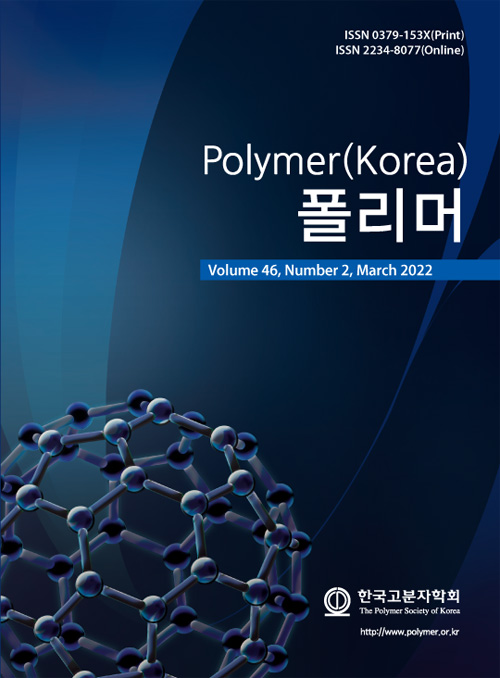
 Copyright(c) The Polymer Society of Korea. All right reserved.
Copyright(c) The Polymer Society of Korea. All right reserved.